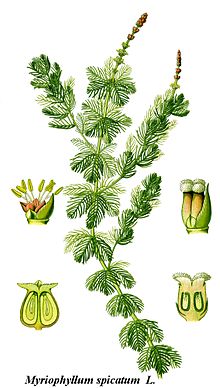Myriophyllum spicatum: Difference between revisions
Cwmhiraeth (talk | contribs) →Introduced areas: Adding link to orphan article. |
Jboltonnal (talk | contribs) |
||
| Line 35: | Line 35: | ||
==External links== |
==External links== |
||
* [http://www.invasivespeciesinfo.gov/aquatics/watermilfoil.shtml Species Profile- Eurasian Watermilfoil (''Myriophyllum spicatum'' L.)], National Invasive Species Information Center, [[United States National Agricultural Library]]. Lists general information and resources for Eurasian Watermilfoil. |
|||
*[http://rbg-web2.rbge.org.uk/cgi-bin/nph-readbtree.pl/feout?FAMILY_XREF=&GENUS_XREF=Myriophyllum&SPECIES_XREF=spicatum&TAXON_NAME_XREF=&RANK= Flora Europaea: ''Myriophyllum spicatum''] |
*[http://rbg-web2.rbge.org.uk/cgi-bin/nph-readbtree.pl/feout?FAMILY_XREF=&GENUS_XREF=Myriophyllum&SPECIES_XREF=spicatum&TAXON_NAME_XREF=&RANK= Flora Europaea: ''Myriophyllum spicatum''] |
||
*[http://tai2.ntu.edu.tw/udth/bin/fot1.exe/browse?bid=3&page=973 Flora of Taiwan: ''Myriophyllum spicatum''] |
*[http://tai2.ntu.edu.tw/udth/bin/fot1.exe/browse?bid=3&page=973 Flora of Taiwan: ''Myriophyllum spicatum''] |
||
Revision as of 14:06, 15 February 2011
| Myriophyllum spicatum | |
|---|---|

| |
| Scientific classification | |
| Kingdom: | |
| (unranked): | |
| (unranked): | |
| (unranked): | |
| Order: | |
| Family: | |
| Genus: | |
| Species: | M. spicatum
|
| Binomial name | |
| Myriophyllum spicatum | |
Myriophyllum spicatum (Spiked Water milfoil or Eurasian water milfoil) is a species of Myriophyllum native to Europe, Asia, and north Africa. It is a submerged aquatic plant, and grows in still or slow-moving water.
Description
Eurasian has slender stems up to 3 m long. The leaves are borne in whorls of four, bipinnate, with the numerous leaflets thread-like, 4-13 mm long. The flowers are produced in the leaf axils on a spike 5-15 cm long held vertically above the water surface, each flower inconspicuous, orange-red, 4-6 mm long. Eurasian water milfoil has 12- 21 pairs of leaflets while North American watermilfoil only has 5-9 pairs.
Distribution
Introduced areas
It has been introduced to North America between the 1950s and 1980s where it has become an invasive species in some areas. As of 2003 Eurasian watermilfoil was found in every state of the contiguous US save for Wyoming and Montana, with Rhode Island, New York, New Jersey, Michigan, Minnesota, and Washington state having the largest areas of infestation. It is commonly believed that people who brought the Eurasian Milfoil to North America in the 1950s were the first to introduce this invasive species. The Okanagan Basin Water Board was set up in British Colombia after it became established in the Okanagan Valley.
Impact
In lakes or other aquatic areas where native aquatic plants are not well established, the Eurasian plant can quickly spread. It has been known to crowd out native plants and create dense mats that interfere with recreational activity. Eurasian watermilfoil can grow from broken off stems which increases the rate in which the plant can spread and grow. In some areas, the Eurasian Watermilfoil is an Aquatic Nuisance Species.
Control
The aquatic moth Acentria ephemerella, the water veneer moth, feeds upon and damages this water milfoil. It has been used as an agent of biological pest control against the plant in North America. The milfoil weevil (Euhrychiopsis lecontei) has also been used as biocontrol.
Since roughly 2000, hand-harvesting of invasive milfoils has shown much success as a management technique. Several organizations in the New England states have undertaken large scale, lake-wide hand-harvesting management programs with extremely successful results. Acknowledgment had to be made that it is impossible to completely eradicate the species once it is established. As a result, maintenance must be done once an infestation has been reduced to afford-ably controlled levels. Well trained divers with proper techniques have been able to effectively control and then maintain many lakes, especially in the Adirondack Park in Northern New York where chemicals, mechanical harvesters, and other disruptive and largely unsuccessful management techniques are banned. The Adirondack Watershed Institute (AWI) of Paul Smiths College is one organization whose research has shown time and again the effectiveness of hand-harvesting techniques. Two past employees of the Institute formed a private company called Aquatic Invasive Management, LLC (AIM)) which has taken the productivity of past hand-harvesting techniques to new heights with private innovation. It is becoming apparent that hand-harvesting is minimally disruptive to the ecology, highly effective per dollar spent, economically beneficial in the form of good paying job creation and universally applicable.
References
External links
- Species Profile- Eurasian Watermilfoil (Myriophyllum spicatum L.), National Invasive Species Information Center, United States National Agricultural Library. Lists general information and resources for Eurasian Watermilfoil.
- Flora Europaea: Myriophyllum spicatum
- Flora of Taiwan: Myriophyllum spicatum
- http://rparticle.web-p.cisti.nrc.ca/rparticle/AbstractTemplateServlet?calyLang=eng&journal=cjfas&volume=63&year=2006&issue=5&msno=f06-010
- Invading Species.com Ontario Ministry of Natural Resources and the Ontario Federation of Anglers and Hunters
- Jepson Manual Treatment
- USDA Plants Profile
- USDA ARS. Foiling Watermilfoil
- Photo gallery
